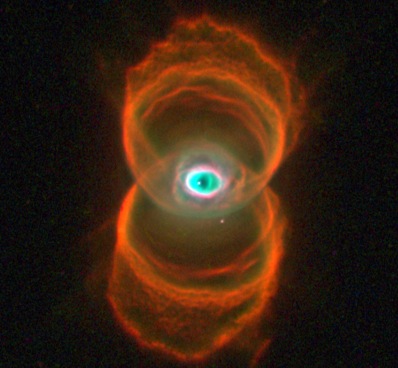
WISE view of a
planetary nebula
DR EMILY BALDWIN
ASTRONOMY NOW
Posted: 18 November 2010


NASA's Wide-field Infrared Survey Explorer (WISE) has detected two rings of fluorescing gas around a pair dying stars.

Left: NGC 1514 as seen in visible light. Right: WISE's infrared view. Blue represents light with a wavelength of 3.4 microns; turquoise is 4.6-micron light; green is 12-micron light; and red is 22- micron light. The dust rings stand out in orange. The greenish glow at the centre is an inner shell of material, blown out more recently than an outer shell that is too faint to be seen in WISE’s infrared view. The white dot in the middle is the central pair of stars, which are too close together for WISE to see separately. Image: NASA/JPL-Caltech/UCLA/Digitized Sky Survey/STScI.
Located 800 light years away in the constellation of Taurus, NGC 1514, also known as the Crystal Ball nebula, formed when a pair of dying stars shed their outer layers of material as their fuel supplies were slowly exhausted. The ring features were shaped when the stars' burped out shells of material, and a later burst of dust ejection collided with those shells.
The rings were spotted for the first time by WISE, which detected their infrared glow – in visible-light images the rings are obscured by bright clouds of gas.

The Hourglass nebula also exhibits rings of material ejected as a Sun-like star reached the end of its life. Image: Raghvendra Sahai and John Trauger (JPL), the WFPC2 science team, and NASA.
“This object has been studied for more than 200 years, but WISE shows us it still has surprises,” says Michael Ressler, a member of the WISE science team at NASA’s Jet Propulsion Laboratory. “I just happened to look up one of my favorite objects in our WISE catalogue and was shocked to see these odd rings.”
Ressler likens the structure of NGC 1514 to the Hourglass nebula, but says it appears unlike anything seen before due to WISE's unique infrared view of the nebula.
WISE is combing through the whole sky for a treasure trove of different objects, from asteroids to stars and galaxies, and will likely turn up more oddball planetary nebulae when the first batch of data is released to the astronomical community early next year. WISE ran out of coolant in September but is continuing as a 'warm' mission, scanning the skies with two of its infrared detectors to snag comets, asteroids and near-Earth objects.
|



